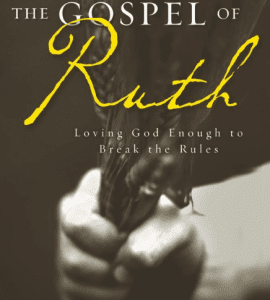A series by John based on The Gospel of Ruth by Carolyn Custis James.
“Even when Ruth does something remarkable and brave, evangelicals have tended to turn her story into a romance and Boaz into the hero who comes to her rescue. Nothing could be further from the truth” (Gospel of Ruth, 13). Ouch. I have to admit that romance story is the framework in which I have placed and preached Ruth’s story. The poor, beautiful Moabite widow girl meets wealthy, kind Hebrew (handsome) Boaz and love happens. “And they lived happily ever after.” This is what we want in Western (American) Christianity—a Disney movie titled “Ruth.” After filling in the harsh historical, cultural, and economic realities informing the lives of Naomi, Ruth, and Boaz, Carolyn Custis James writes, “We set aside the miseries of the past and settle in comfortably for what promises to be a first-rate Cinderella story. . . . These fanciful impressions cloud our vision of the real-life story unfolding and trivialize the powerful interactions playing out before us” (93). The Cinderella view of Ruth is a lazy view.
Carolyn James takes on the hard challenge of watching and understanding Naomi, Ruth, and Boaz within their Ancient Near Eastern culture. James admits that she has studied Ruth with one pressing question in mind, “Is God good for women?” (24-25). What many of us know about the harsh realities for widows in the Ancient Near East, we somehow suspend when interpreting the Book of Ruth. The Ancient Near East was a man’s world. Men were primary; women were secondary and dependent. Sadly, some segments of USAmerican evangelicalism are still a man’s world.
In the Preface, Dr. Robert L. Hubbard, Jr., notes that Carolyn James “must live with women in two different worlds: the Ancient Near Eastern world of Moab and Bethlehem and the modern world of her readers” (10). Hubbard agrees about the harsh realities for women, “The ancient world is also a world run by men, so life for women is tricky. The work is hard, but the pace of life leisurely. A [Hebrew] widow can remarry, but only to a relative of her late husband” (10). Heightening the tension even more for Ruth’s story is that it is set during the era of “the judges” when rebellion from God and its resulting chaos marked Hebrew life.
What surprises us about Ruth is this: within the first five verses of the book, the husbands (the men) in three women’s lives are taken out of the picture wholesale by death. Boom. What will three women—Naomi, Orpah, and Ruth—do to live? It’s a man’s world after all. Carolyn’s controlling question is critical now: Is God good for women? To answer the question, Carolyn isn’t launching out solo. She marshals the teaching and wisdom of scholars like Robert L. Hubbard Jr., Katherine Doob Sakenfield, Edward F. Campbell Jr., Frederic Bush, Bruce K. Waltke, and Ellen Davis. (I had Dr. Waltke as a professor for learning Hebrew, the Psalms, Old Testament Introduction (and Theology), and Old Testament textual criticism. My deep appreciation for the Old Testament is traceable to Dr. Waltke’s influence on my life.) Now, I add Carolyn Custis James as a significant voice in my new appreciation of the Book of Ruth in particular.
To use Scot McKnight’s terminology, how do Naomi, Ruth, and Boaz as Eikons of God transcend the Ancient Near Eastern cultural constraints so that the Living God and his goodness is put on display? We’ll pursue this in posts to come.












